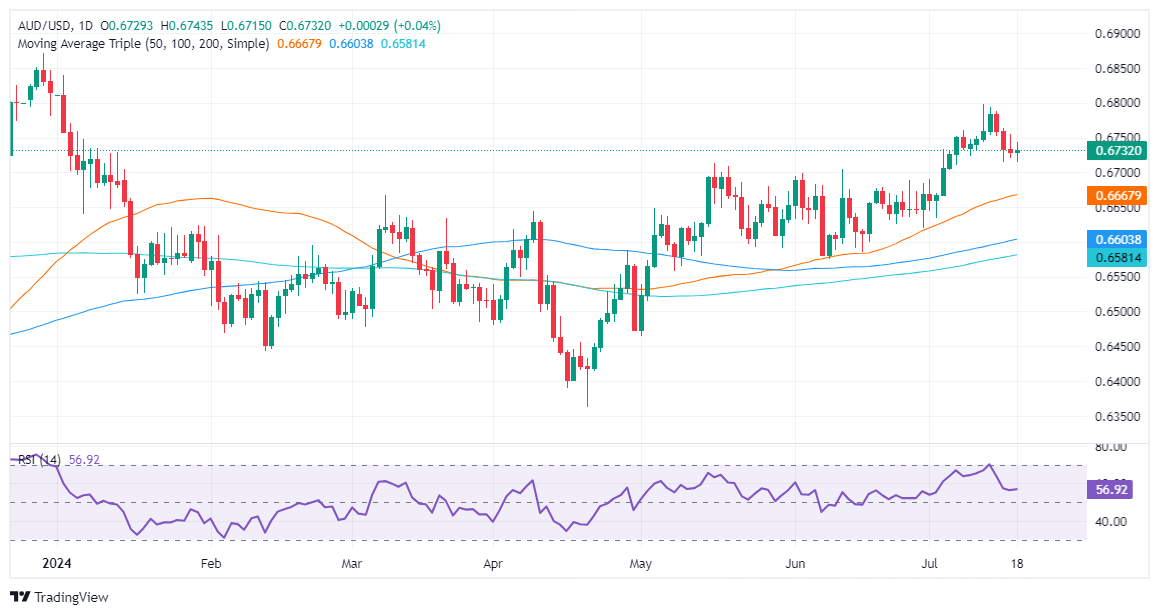- AUD/USD is up 0.09%, boosted by strong Australian jobs data and weaker US employment.
- Australian employment rises by 50,200 jobs, beating forecasts; unemployment rate rises slightly to 4.1%.
- US jobless claims rose to 243,000, suggesting a easing in the labor market and encouraging a feeling of risk appetite.
The Australian Dollar extended its gains on Thursday after data from the United States (US) showed that the labor market continues to cool, following last week’s initial jobless claims report. Therefore, the AUD/USD pair is trading at 0.6734, gaining 0.09%.
AUD/USD advances on strong Australian jobs data
US equity futures point to a positive start, reflecting a risk-on environment. This helps the high-beta status of the Australian dollar, which was boosted during the Asian session following the release of a strong jobs report.
The Australian Bureau of Statistics (ABS) revealed that job changes rose by 50,200 jobs, beating estimates of 20,000 and the May reading of 39,500. However, the unemployment rate rose from 4% to 4.1%.
The data is likely to test the patience of the Reserve Bank of Australia (RBA), as TD analysts noted in a note: “With inflation measures continuing to rise since the start of this year and the labour market holding up better than expected, the RBA’s patience in staying on hold is likely to be tested.”
Aside from this, the recently released jobless claims figures report shows “some easing” in the US labor market. The number of Americans who filed for unemployment benefits in the week ending July 13 beat estimates by 230,000, coming in at 243,000, and exceeded the previous week’s reading of 223,000.
AUD/USD Price Analysis: Technical Outlook
From a technical perspective, the AUD/USD uptrend remains intact, although the drop from the yearly highs of 0.6798 towards the current exchange rate has opened the door to test the May 4 high, which turned into support at 0.6714.
Further strength in the US Dollar could push the pair below 0.6700, opening the door for a challenge of the 50-day moving average (DMA) at 0.6667, ahead of the 100-day moving average (DMA) at 0.6603. On the other hand, if buyers keep the AUD/USD exchange rate above 0.6700, that could pave the way for a test of the yearly high at 0.6793.
The Australian Dollar
One of the most important factors for the Australian Dollar (AUD) is the level of interest rates set by the Reserve Bank of Australia (RBA). Since Australia is a resource-rich country, another key factor is the price of its largest export, iron ore. The health of the Chinese economy, its largest trading partner, is a factor, as is inflation in Australia, its growth rate and the Trade Balance. Market sentiment, i.e. whether investors are betting on riskier assets (risk-on) or seeking safe havens (risk-off), is also a factor, with risk-on being positive for the AUD.
The Reserve Bank of Australia (RBA) influences the Australian Dollar (AUD) by setting the level of interest rates that Australian banks can lend to each other. This influences the level of interest rates in the economy as a whole. The RBA’s main objective is to maintain a stable inflation rate of 2%-3% by adjusting interest rates up or down. Relatively high interest rates compared to other major central banks support the AUD, and the opposite for relatively low ones. The RBA can also use quantitative easing and tightening to influence credit conditions, with the former being negative for the AUD and the latter positive for the AUD.
China is Australia’s largest trading partner, so the health of the Chinese economy greatly influences the value of the Australian Dollar (AUD). When the Chinese economy is doing well, it buys more raw materials, goods and services from Australia, which increases demand for the AUD and drives up its value. The opposite occurs when the Chinese economy is not growing as fast as expected. Therefore, positive or negative surprises in Chinese growth data often have a direct impact on the Australian Dollar.
Iron ore is Australia’s largest export, worth $118 billion per year as of 2021 data, with China being its main destination. The price of iron ore can therefore be a driver of the Australian dollar. Typically, if the price of iron ore rises, the AUD rises as well, as aggregate demand for the currency increases. The opposite occurs when the price of iron ore falls. Higher iron ore prices also tend to lead to a higher probability of a positive trade balance for Australia, which is also positive for the AUD.
The trade balance, which is the difference between what a country earns from its exports and what it pays for its imports, is another factor that can influence the value of the Australian dollar. If Australia produces highly sought-after exports, its currency will gain value solely because of the excess demand created by foreign buyers wanting to purchase its exports versus what it spends on buying imports. Therefore, a positive net trade balance strengthens the AUD, with the opposite effect if the trade balance is negative.
Source: Fx Street
I am Joshua Winder, a senior-level journalist and editor at World Stock Market. I specialize in covering news related to the stock market and economic trends. With more than 8 years of experience in this field, I have become an expert in financial reporting.








